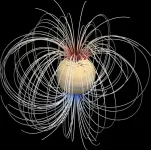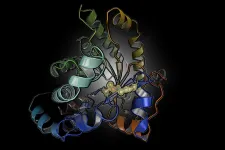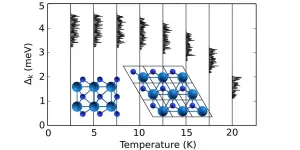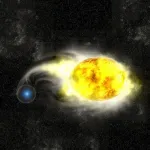Johns Hopkins scientists model Saturn's interior
Researchers simulate conditions necessary for planet's unique magnetic field
2021-05-05
(Press-News.org) New Johns Hopkins University simulations offer an intriguing look into Saturn's interior, suggesting that a thick layer of helium rain influences the planet's magnetic field.
The models, published this week in AGU Advances, also indicate that Saturn's interior may feature higher temperatures at the equatorial region, with lower temperatures at the high latitudes at the top of the helium rain layer.
It is notoriously difficult to study the interior structures of large gaseous planets, and the findings advance the effort to map Saturn's hidden regions.
"By studying how Saturn formed and how it evolved over time, we can learn a lot about the formation of other planets similar to Saturn within our own solar system, as well as beyond it," said co-author Sabine Stanley, a Johns Hopkins planetary physicist.
Saturn stands out among the planets in our solar system because its magnetic field appears to be almost perfectly symmetrical around the rotation axis. Detailed measurements of the magnetic field gleaned from the last orbits of NASA's Cassini mission provide an opportunity to better understand the planet's deep interior, where the magnetic field is generated, said lead author Chi Yan, a Johns Hopkins PhD candidate.
By feeding data gathered by the Cassini mission into powerful computer simulations similar to those used to study weather and climate, Yan and Stanley explored what ingredients are necessary to produce the dynamo--the electromagnetic conversion mechanism--that could account for Saturn's magnetic field.
"One thing we discovered was how sensitive the model was to very specific things like temperature," said Stanley, who is also a Bloomberg Distinguished Professor at Johns Hopkins in the Department of Earth & Planetary Sciences and the Space Exploration Sector of the Applied Physics Lab. "And that means we have a really interesting probe of Saturn's deep interior as far as 20,000 kilometers down. It's a kind of X-ray vision."
Strikingly, Yan and Stanley's simulations suggest that a slight degree of non-axisymmetry could actually exist near Saturn's north and south poles.
"Even though the observations we have from Saturn look perfectly symmetrical, in our computer simulations we can fully interrogate the field," said Stanley.
Direct observation at the poles would be necessary to confirm it, but the finding could have implications for understanding another problem that has vexed scientists for decades: how to measure the rate at which Saturn rotates, or, in other words, the length of a day on the planet.
INFORMATION:
This project was conducted using computational resources at the Maryland Advanced Research Computing Center (MARCC).
[Attachments] See images for this press release:

ELSE PRESS RELEASES FROM THIS DATE:
2021-05-05
The incorporation of boron into polycyclic aromatic hydrocarbon systems leads to interesting chromophoric and fluorescing materials for optoelectronics, including organic light-emitting diodes (OLEDS) and field-effect transistors, as well as polymer-based sensors. In the journal Angewandte Chemie, a research team has now introduced a new anionic organoborane compound. Synthesis of the borafluorene succeeded through the use of carbenes.
Borafluorene is a particularly interesting boron-containing building block. It is a system of three carbon rings joined at the edges: two six-membered and one central five-membered ring, whose free tip is the boron atom. While neutral, radical, and cationic (positively ...
2021-05-05
Proteins perform a vast array of functions in the cell of every living organism with critical roles in almost every biological process. Not only do they run our metabolism, manage cellular signaling and are in charge of energy production, as antibodies they are also the frontline workers of our immune system fighting human pathogens like the coronavirus. In view of these important duties, it is not surprising that the activity of proteins is tightly controlled. There are numerous chemical switches that control the structure and, therefore, the function of proteins in response to changing environmental conditions and stress. ...
2021-05-05
Philadelphia, May 5, 2021--When Luke Terrio was about seven months old, his mother began to realize something was off. He had constant ear infections, developed red spots on his face, and was tired all the time. His development stagnated, and the antibiotics given to treat his frequent infections stopped working. His primary care doctor at Children's Hospital of Philadelphia (CHOP) ordered a series of blood tests and quickly realized something was wrong: Luke had no antibodies.
At first, the CHOP specialists treating Luke thought he might have X-linked agammaglobulinemia (XLA), a rare immunodeficiency syndrome seen in children. However, as the CHOP research team continued investigating Luke's case, they realized Luke's condition was unlike any disease described ...
2021-05-05
Pesticides have been used in European agriculture for more than 70 years, so monitoring their presence, levels and their effects in European soils quality and services is needed to establish protocols for the use and the approval of new plant protection products.
In an attempt to deal with this issue, a team led by the prof. Dr. Violette Geissen from Wageningen University (Netherlands) have analysed 340 soil samples originating from three European countries to compare the contentdistribution of pesticide cocktails in soils under organic farming practices and soils under conventional practices. This study was a combined effort of 3 EC funded projects addressing soil
quality: RECARE (http://www.recare-project.eu/), iSQAPER (http://www.isqaper-project.eu) ...
2021-05-05
T-cells play a central role in our immune system: by means of their so-called T-cell receptors (TCR) they make out dangerous invaders or cancer cells in the body and then trigger an immune reaction. On a molecular level, this recognition process is still not sufficiently understood.
Intriguing observations have now been made by an interdisciplinary Viennese team of immunologists, biochemists and biophysicists. In a joint project funded by the Vienna Science and Technology Fund and the FWF, they investigated which mechanical processes take place when an antigen is recognized: ...
2021-05-05
Larger bumblebees are more likely to go out foraging in the low light of dawn, new research shows.
University of Exeter scientists used RFID - similar technology to contactless card payments - to monitor when bumblebees of different sizes left and returned to their nest.
The biggest bees, and some of the most experienced foragers (measured by number of trips out), were the most likely to leave in low light.
Bumblebee vision is poor in low light, so flying at dawn or dusk raises the risk of getting lost or being eaten by a predator.
However, the bees benefit from extra foraging time and fewer competitors for pollen in the early morning.
"Larger bumblebees have bigger eyes than their smaller-sized nest mates and many other bees, and can therefore see better in dim light," said lead author ...
2021-05-05
Superconductivity in two-dimensional (2D) systems has attracted much attention in recent years, both because of its relevance to our understanding of fundamental physics and because of potential technological applications in nanoscale devices such as quantum interferometers, superconducting transistors and superconducting qubits.
The critical temperature (Tc), or the temperature under which a material acts as a superconductor, is an essential concern. For most materials, it is between absolute zero and 10 Kelvin, that is, between -273 Celsius and -263 Celsius, too cold to be of any practical use. Focus has then been on finding materials with a higher Tc.
While researchers have discovered materials ...
2021-05-05
A curiously yellow pre-supernova star has caused astrophysicists to re-evaluate what's possible at the deaths of our Universe's most massive stars. The team describe the peculiar star and its resulting supernova in a new study published today in Monthly Notices of the Royal Astronomical Society.
At the end of their lives, cool, yellow stars are typically shrouded in hydrogen, which conceals the star's hot, blue interior. But this yellow star, located 35 million light years from Earth in the Virgo galaxy cluster, was mysteriously lacking this crucial hydrogen layer at the time of its explosion.
"We haven't seen this scenario before," said Charles Kilpatrick, postdoctoral fellow at Northwestern ...
2021-05-05
How can a highly effective drug be transported to the precise location in the body where it is needed? In the journal Angewandte Chemie, chemists at Heinrich Heine University Düsseldorf (HHU) together with colleagues in Aachen present a solution using a molecular cage that opens through ultrasonification.
Supramolecular chemistry involves the organization of molecules into larger, higher-order structures. When suitable building blocks are chosen, these systems 'self-assemble' from their individual components.
Certain supramolecular compounds are well suited for 'host-guest chemistry'. In such cases, a host structure encloses a guest molecule and can shield, protect and transport it away from its environment. This is a specialist field of Dr. Bernd M. Schmidt and ...
2021-05-05
The United States-Mexico border traverses through large expanses of unspoiled land in North America, including a newly discovered worldwide hotspot of bee diversity. Concentrated in 16 km2 of protected Chihuahuan Desert are more than 470 bee species, a remarkable 14% of the known United States bee fauna.
This globally unmatched concentration of bee species is reported by Dr. Robert Minckley of the University of Rochester and William Radke of the United States Fish and Wildlife Service in the open-access, peer-reviewed Journal of Hymenoptera Research.
Scientists studying native U.S. bees have long recognized that the Sonoran and Chihuahuan deserts of North America, home to species with interesting life histories, have high bee biodiversity. Exactly how many species ...
LAST 30 PRESS RELEASES:
[Press-News.org] Johns Hopkins scientists model Saturn's interior
Researchers simulate conditions necessary for planet's unique magnetic field






